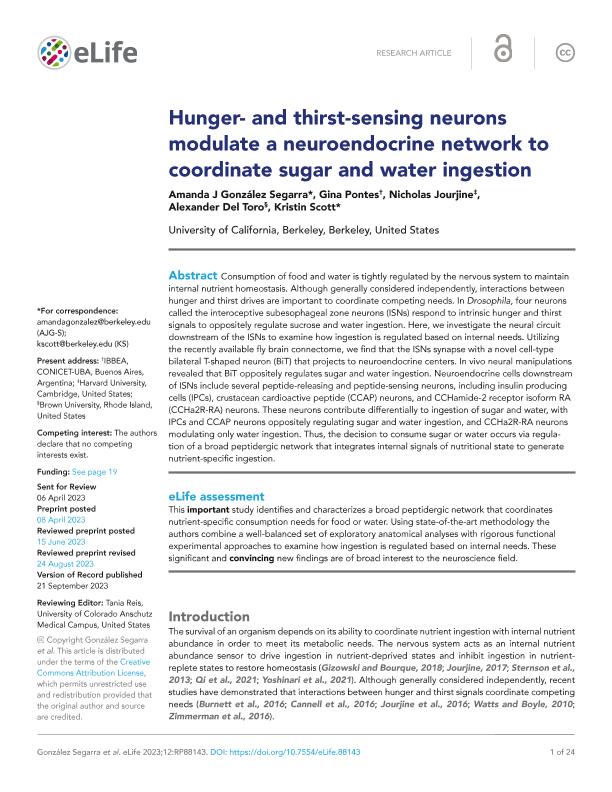Artículo
Hunger- and thirst-sensing neurons modulate a neuroendocrine network to coordinate sugar and water ingestion
González Segarra, Amanda J.; Barcelos Pontes, Gina ; Jourjine, Nicholas; Del Toro, Alexander; Scott, Kristin
; Jourjine, Nicholas; Del Toro, Alexander; Scott, Kristin
 ; Jourjine, Nicholas; Del Toro, Alexander; Scott, Kristin
; Jourjine, Nicholas; Del Toro, Alexander; Scott, Kristin
Fecha de publicación:
09/2023
Editorial:
eLife Sciences Publications
Revista:
eLife
ISSN:
2050-084X
Idioma:
Inglés
Tipo de recurso:
Artículo publicado
Clasificación temática:
Resumen
Consumption of food and water is tightly regulated by the nervous system to maintain internal nutrient homeostasis. Although generally considered independently, interactions between hunger and thirst drives are important to coordinate competing needs. In Drosophila, four neurons called the interoceptive subesophageal zone neurons (ISNs) respond to intrinsic hunger and thirst signals to oppositely regulate sucrose and water ingestion. Here, we investigate the neural circuit downstream of the ISNs to examine how ingestion is regulated based on internal needs. Utilizing the recently available fly brain connectome, we find that the ISNs synapse with a novel cell-type bilateral T-shaped neuron (BiT) that projects to neuroendocrine centers. In vivo neural manipulations revealed that BiT oppositely regulates sugar and water ingestion. Neuroendocrine cells downstream of ISNs include several peptide-releasing and peptide-sensing neurons, including insulin producing cells (IPCs), crustacean cardioactive peptide (CCAP) neurons, and CCHamide-2 receptor isoform RA (CCHa2R-RA) neurons. These neurons contribute differentially to ingestion of sugar and water, with IPCs and CCAP neurons oppositely regulating sugar and water ingestion, and CCHa2R-RA neurons modulating only water ingestion. Thus, the decision to consume sugar or water occurs via regulation of a broad peptidergic network that integrates internal signals of nutritional state to generate nutrient-specific ingestion.
Palabras clave:
DROSOPHILA
,
TASTE
,
NEURAL CIRCUIT
Archivos asociados
Licencia
Identificadores
Colecciones
Articulos(IBBEA)
Articulos de INSTITUTO DE BIODIVERSIDAD Y BIOLOGIA EXPERIMENTAL Y APLICADA
Articulos de INSTITUTO DE BIODIVERSIDAD Y BIOLOGIA EXPERIMENTAL Y APLICADA
Citación
González Segarra, Amanda J.; Barcelos Pontes, Gina; Jourjine, Nicholas; Del Toro, Alexander; Scott, Kristin; Hunger- and thirst-sensing neurons modulate a neuroendocrine network to coordinate sugar and water ingestion; eLife Sciences Publications; eLife; 12; 9-2023; 1-24
Compartir
Altmétricas



